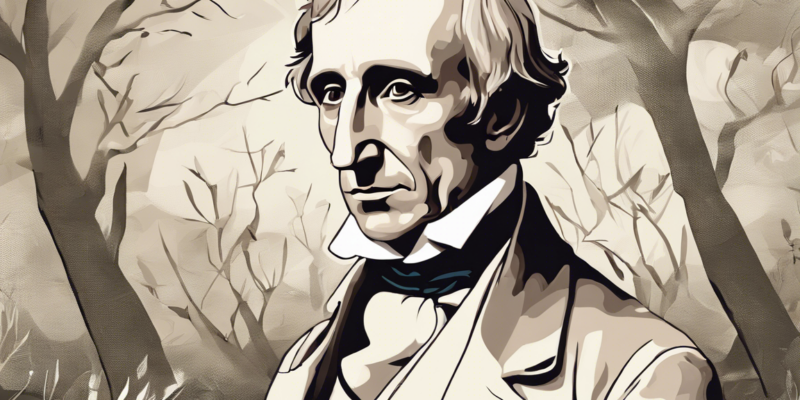Introduction
William Wordsworth, a prominent figure in the English Romantic movement, is renowned for his poetic exploration of nature and its profound impact on the human experience. His works, characterized by lyrical beauty and deep emotional resonance, reflect a deep connection with the natural world. In this article, we will delve into Wordsworth’s literary relationship with nature, examining the themes, motifs, and philosophies that define his poetic exploration of the natural world.
Early Influences and Philosophical Foundations
Wordsworth’s formative years were spent amidst the picturesque landscapes of the Lake District in England, a setting that profoundly influenced his poetic sensibilities. The romantic beauty of the region, with its rolling hills, serene lakes, and rugged mountains, served as a constant source of inspiration for Wordsworth’s poetry. His encounters with nature during his childhood laid the groundwork for his belief in the transformative power of the natural world on the human spirit.
Central to Wordsworth’s philosophy is the concept of “nature as teacher,” the idea that nature serves as a guiding force that imparts valuable lessons and insights to individuals. In his poetry, Wordsworth often depicts nature as a wise mentor, capable of nurturing the soul and offering solace in times of turmoil. This belief in the redemptive qualities of nature is a recurring motif in Wordsworth’s works, emphasizing the healing and restorative powers of the natural world.
Themes and Motifs in Wordsworth’s Poetry
The theme of nature occupies a central place in Wordsworth’s poetry, serving as the backdrop against which human emotions and experiences unfold. His deep appreciation for the beauty and majesty of the natural world is evident in poems such as “Lines Composed a Few Miles Above Tintern Abbey,” where he reflects on the restorative effects of nature on the human spirit. Through vivid descriptions of the natural landscape, Wordsworth seeks to evoke a sense of awe and wonder in his readers, inviting them to contemplate the transcendent power of nature.
One of the key motifs in Wordsworth’s poetry is the use of natural imagery to convey emotional states and psychological conditions. For Wordsworth, nature serves as a mirror that reflects the inner turbulence and serenity of the human psyche. In poems like “I Wandered Lonely as a Cloud,” he uses the image of daffodils dancing in the breeze to capture the fleeting moments of joy and contentment that nature can inspire.
Wordsworth’s Environmental Vision
Beyond his personal connection with nature, Wordsworth also articulated a visionary environmental ethic that emphasized the intrinsic value of the natural world. In his poetry, he often speaks out against exploitation and abuse of the environment, warning of the dire consequences of humanity’s disconnection from the natural world. Wordsworth’s environmental consciousness, expressed through his reverence for nature and advocacy for its preservation, foreshadowed contemporary environmental movements and the urgent call for sustainability and conservation.
Legacy and Influence
Wordsworth’s profound exploration of nature in his poetry has left an indelible mark on the literary landscape, influencing generations of poets and writers who followed in his footsteps. His emphasis on the spiritual and emotional dimensions of the natural world continues to resonate with readers today, inspiring a renewed appreciation for the beauty and power of nature. Wordsworth’s enduring legacy lies in his ability to capture the transcendent quality of nature and its capacity to evoke profound emotions and insights in human beings.
Conclusion
In conclusion, William Wordsworth’s literary connection with nature stands as a testament to the enduring power and beauty of the natural world. Through his poetry, Wordsworth invites readers to embark on a spiritual and emotional journey through the pristine landscapes of the Lake District, urging them to contemplate the mysteries and wonders of the natural world. His philosophical insights, artistic vision, and environmental ethic continue to inspire and enrich our understanding of nature and its profound impact on the human experience.
FAQs:
- What are some of the common themes in Wordsworth’s poetry?
-
Nature, emotions, spirituality, transcendence, and the human experience are some of the recurring themes in Wordsworth’s poetry.
-
How did Wordsworth’s childhood experiences influence his poetic vision?
-
Wordsworth’s upbringing amidst the natural beauty of the Lake District profoundly shaped his poetic sensibilities and his belief in the restorative power of nature.
-
What is Wordsworth’s view on the relationship between nature and humanity?
-
Wordsworth viewed nature as a source of inspiration, beauty, and wisdom, emphasizing the symbiotic relationship between the natural world and human beings.
-
How did Wordsworth’s poetry contribute to the Romantic movement in literature?
-
Wordsworth’s emphasis on nature, emotions, and the inner life of individuals helped define the core tenets of Romanticism and influence subsequent generations of poets.
-
What is the significance of Wordsworth’s environmental vision in his poetry?
-
Wordsworth’s environmental vision underscores the critical importance of sustainability, conservation, and respect for the natural world, anticipating contemporary environmental concerns.
-
Which of Wordsworth’s poems best exemplifies his connection with nature?
- Poems like “Lines Composed a Few Miles Above Tintern Abbey” and “I Wandered Lonely as a Cloud” vividly illustrate Wordsworth’s deep appreciation for nature and its transformative effect on the human spirit.



Comments